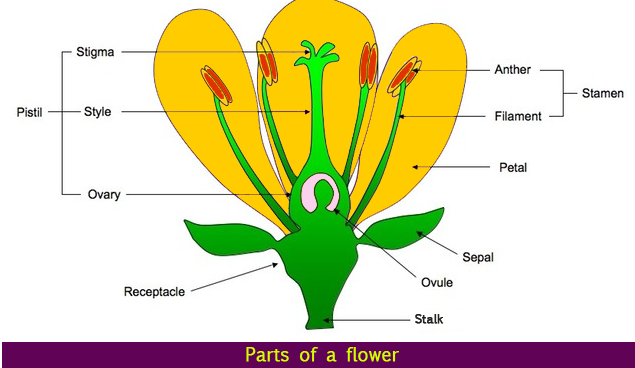
The innermost part of a flower is called the ________.
Answer
375.3k+ views
Hint: As flowers help reproduction in plants, the innermost part of it is known as the female reproductive part. It is located centrally and consists of a swollen base, the ovary, a pollen receptive tip and the stigma.
Complete answer:
A flower can be defined as the reproductive part of any angiosperms as they carry out sexual reproduction in them. A flower has four different parts - the calyx, corolla, androecium and gynoecium. It is the androecium and gynoecium which contains the male and female reproductive organs of the plant respectively.
The calyx is the outermost part of the flower mainly containing the sepals. They are a green and leaf-like formation that protects the flower during its early stage also called the bud stage. The Corolla of a flower is found inside the calyx and contains coloured petals. These help in alluring and attracting insects for pollination. The androecium is the next part after the corolla and it typically consists of stamens which are the male reproductive element of the flower and is composed of two parts anther and filament. The gynoecium is the innermost whorl of a flower consisting of pistils, the female reproductive organs of the flower.
Carpel, individually or collectively known as pistils which are the female part of the plants and is composed of three parts stigma, style and ovary. Pistils collectively form the gynoecium, in distinction to the male reproductive parts, androecium. A pistil may have one carpel called the simple pistil or more carpels called the compound pistil joined partially (in mustard) or completely joined (in lily). A flower containing separate pistils is termed apocarpous and if more than two its is syncarpous.

The innermost part of a flower is known as the pistil.
Note: Pistils and the ovary is the basal swollen portion of the pistil and the wall of the ovary after fertilization is known as the pericarp. Carpels are the innermost whorls of flowers. In pollination, pollen grains land on the stigma and then germinate which forms a pollen tube that grows down through the tissue of the style to deposit sperm in the ovary.
Complete answer:
A flower can be defined as the reproductive part of any angiosperms as they carry out sexual reproduction in them. A flower has four different parts - the calyx, corolla, androecium and gynoecium. It is the androecium and gynoecium which contains the male and female reproductive organs of the plant respectively.
The calyx is the outermost part of the flower mainly containing the sepals. They are a green and leaf-like formation that protects the flower during its early stage also called the bud stage. The Corolla of a flower is found inside the calyx and contains coloured petals. These help in alluring and attracting insects for pollination. The androecium is the next part after the corolla and it typically consists of stamens which are the male reproductive element of the flower and is composed of two parts anther and filament. The gynoecium is the innermost whorl of a flower consisting of pistils, the female reproductive organs of the flower.
Carpel, individually or collectively known as pistils which are the female part of the plants and is composed of three parts stigma, style and ovary. Pistils collectively form the gynoecium, in distinction to the male reproductive parts, androecium. A pistil may have one carpel called the simple pistil or more carpels called the compound pistil joined partially (in mustard) or completely joined (in lily). A flower containing separate pistils is termed apocarpous and if more than two its is syncarpous.

The innermost part of a flower is known as the pistil.
Note: Pistils and the ovary is the basal swollen portion of the pistil and the wall of the ovary after fertilization is known as the pericarp. Carpels are the innermost whorls of flowers. In pollination, pollen grains land on the stigma and then germinate which forms a pollen tube that grows down through the tissue of the style to deposit sperm in the ovary.
Recently Updated Pages
Glucose when reduced with HI and red Phosphorus gives class 11 chemistry CBSE

The highest possible oxidation states of Uranium and class 11 chemistry CBSE

Find the value of x if the mode of the following data class 11 maths CBSE

Which of the following can be used in the Friedel Crafts class 11 chemistry CBSE

A sphere of mass 40 kg is attracted by a second sphere class 11 physics CBSE

Statement I Reactivity of aluminium decreases when class 11 chemistry CBSE

Trending doubts
10 examples of friction in our daily life

One Metric ton is equal to kg A 10000 B 1000 C 100 class 11 physics CBSE

Difference Between Prokaryotic Cells and Eukaryotic Cells

State and prove Bernoullis theorem class 11 physics CBSE

What organs are located on the left side of your body class 11 biology CBSE

How many valence electrons does nitrogen have class 11 chemistry CBSE




